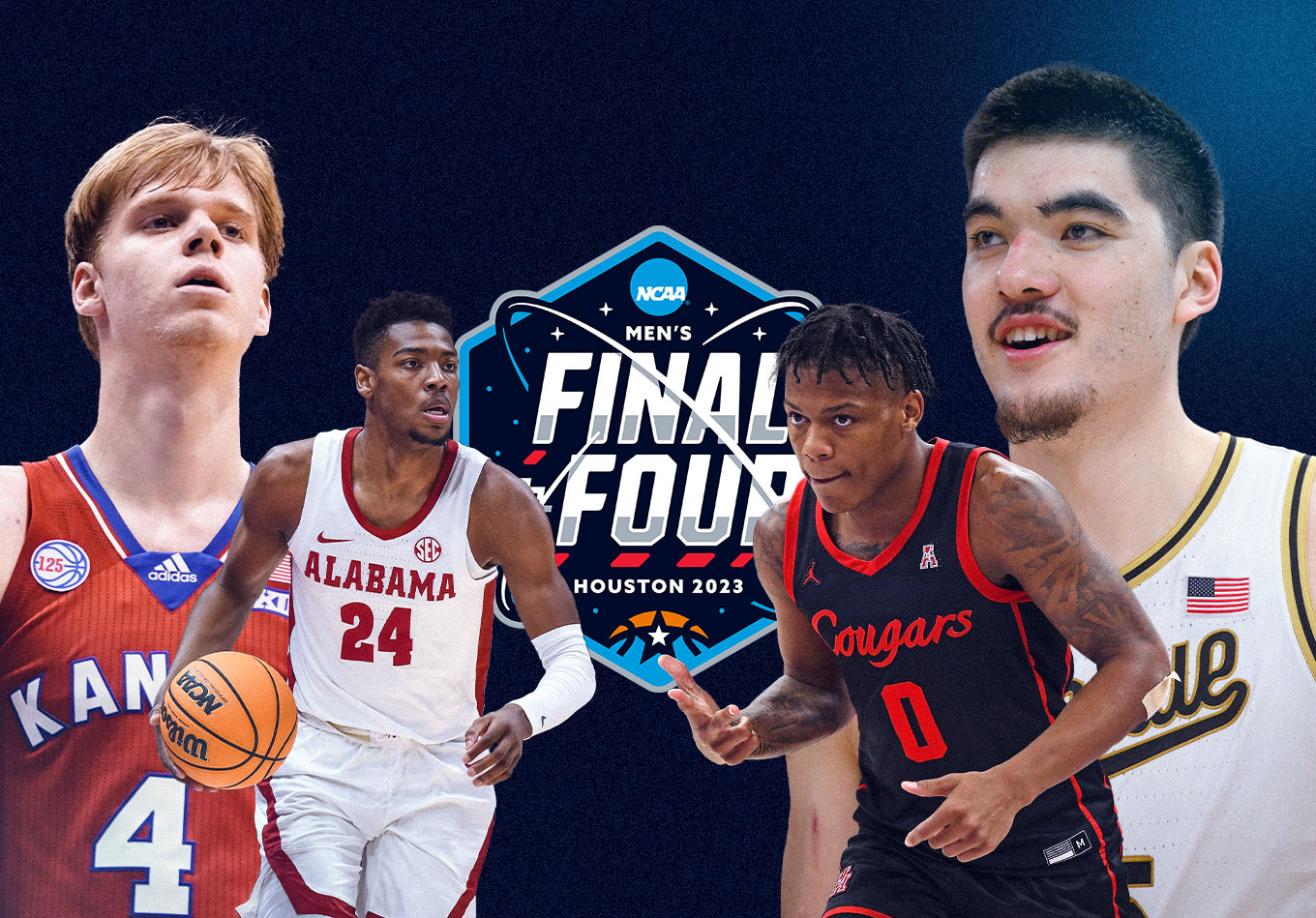It’s time.
After more than four months of basketball, 32 conference tournaments, an endless amount of chaos and the drama of Selection Sunday, we are finally here. The best tournament in sports. March Madness.
I’ve been writing college basketball notes all year. Do I know who is going to win? No clue.
Our bracket predictions for the NCAA Tournament have been released. We simulated the tournament thousands of times to find the chances of each team making it to every round in March. This will be updated constantly throughout the tourney, so make sure to check in to see who changes and where.
We are simulating the NCAA Tournament with TRACR, our Team Rating Adjusted for Conference and Roster. TRACR, which we also have for college football and women’s college basketball, is a net efficiency metric that calculates a team’s points per possession on both sides of the ball, adjusted by the team it plays. The model rewards teams that do well against good teams and punishes those that do poorly against weaker squads.
Don’t believe in our predictions? Well, TRACR did a great job at predicting our conference tournaments. TRACR’s predicted champion for each conference made it to the conference championship game in 26 of the 32 championship games. Of the teams that won its conference tournament, 17 of the 32 were TRACR’s top prediction and 27 of the 32 had either the highest- or second-highest chances of winning.
Not everyone hit on Drake, Montana State, or Duke – we did. So here are some of our thoughts about how the model views the 2023 NCAA Tournament bracket:
West is Best
First off, the fact that Kansas (No. 8 in TRACR) did not make it to the Midwest Region over Houston (No. 1) is a little puzzling.
Yes, the Cougars rank higher in TRACR, but the Jayhawks’ 17-7 Quad 1 record and toughest strength of schedule in the country made it seem like they would get the edge. Both teams were beaten handily in their conference championship game, though both had reasons for it.
It must have been a tough selection, but it does show that the NET might have more of an impact in seeding than we think. Houston is No. 1 in the NET while Kansas is ranked ninth. In addition to Kansas not being able to potentially play in Kansas City for the regional semifinals and finals, it will have to fight through the most difficult path of the four regions.
The West Region is the deepest, most challenging group by far with an average TRACR of 19.7.
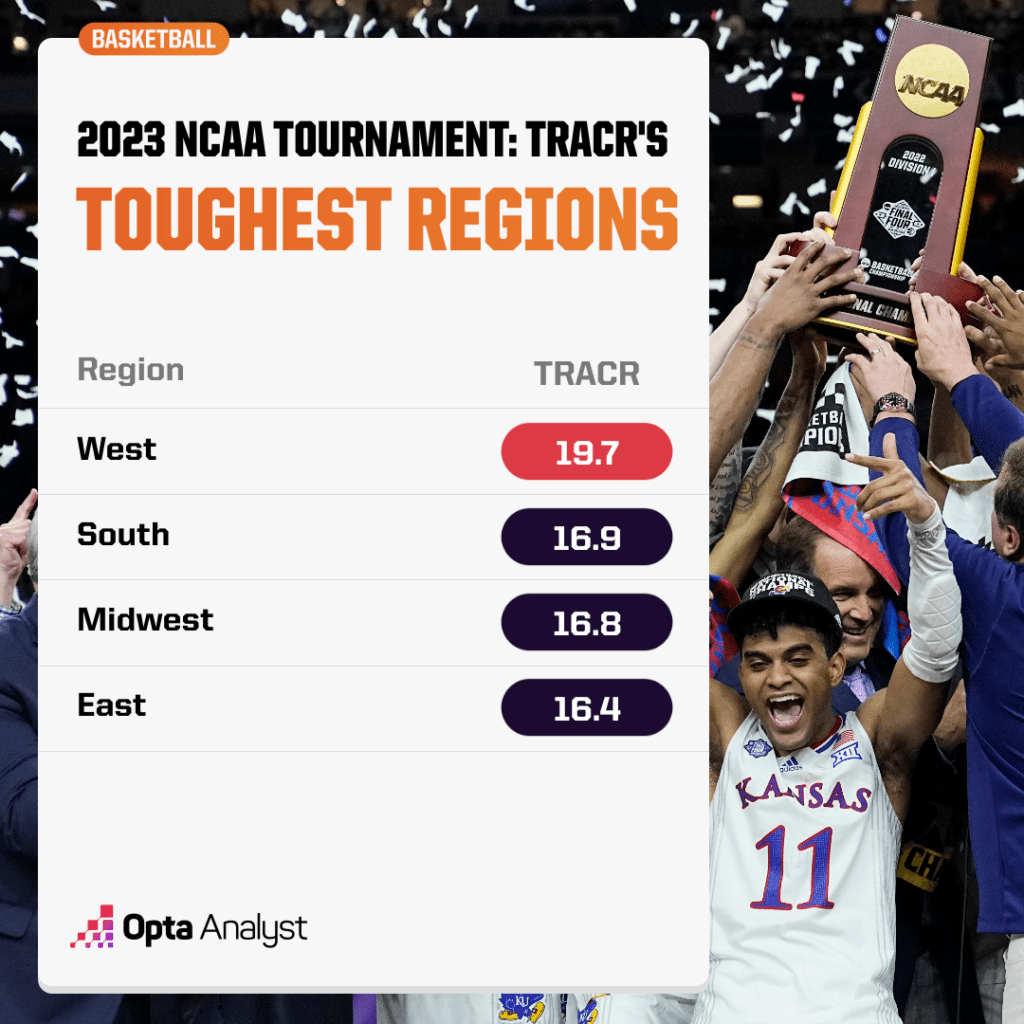
The South, Midwest and East Regions are properly balanced, while the West has a lot of tough teams that could fight through. This is why Kansas has the lowest chance of making it to the Final Four among the other top seeds at just 13.7%. Houston, meanwhile, has a 33.8% chance to make it to the third weekend.
Part of the reason that the West is so challenging is that it has UConn as a fourth seed, which is lower than its overall TRACR ranking (No. 3). The Huskies lost by two points to Marquette (13th) in the Big East tournament semifinals, but they tout an impressive resume going into their first-round matchup with Rick Pitino’s Iona.
UConn, which could face either fifth-seeded Saint Mary’s or 12th-seeded VCU in the second round, went undefeated in nonconference play while outscoring opponents by an average of 26.5 points. Watch out for them as a possible Final Four contender.
UCLA (No. 6) and Gonzaga (No. 4) as the second and third seeds, respectively, do not make this region any easier. The Bruins lost their conference championship game to Arizona (12th) in a close one, but that came after they had won 12 straight. Gonzaga crushed Saint Mary’s (15th) in its conference championship game by 26.
UCLA has a 23.0% chance to win the region and an 8.2% chance to win its 12th NCAA title, per TRACR. Gonzaga has similar projections, with a 22.5% chance to make it to the Final Four and a 6.4% chance to win it all.
See why this is such a problem for Kansas? There are four teams in this region in TRACR’s top 10. It’s possible that whichever team makes it through will go on to hoist the trophy in Houston.
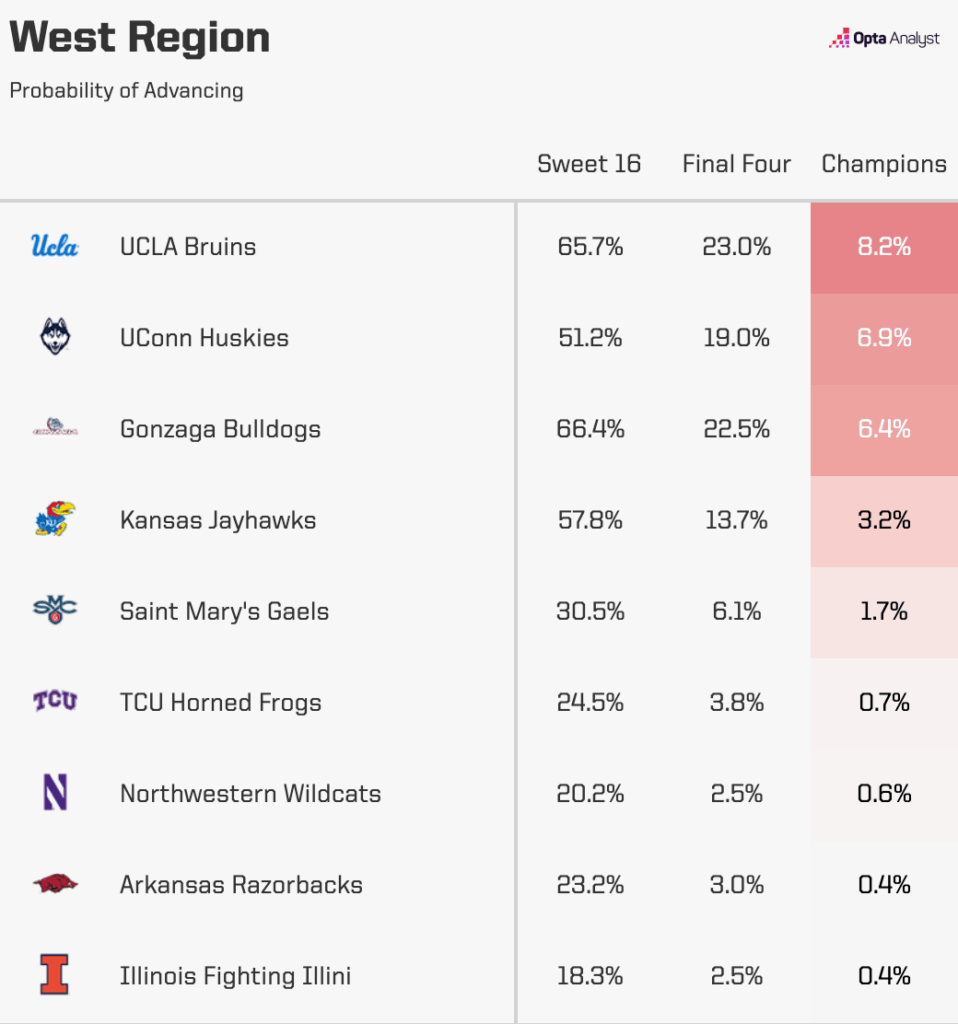
Great 8-9s
Last season, we had one solid 8-9 matchup (Creighton over San Diego State in overtime) and three double-digit games. Memphis beat Boise State by 11, TCU beat Seton Hall by 25 and North Carolina beat Marquette by 32! It seems like the committee did not do a good job overall in pairing those 8-9 seeds. Some were obvious picks over the others, especially that Tar Heels selection.
This year, however, I think the committee did an excellent job of pairing 8-9 teams. But according to TRACR, some of those teams should have had a higher seed and that could spell trouble for top seeds in the second round.
The Maryland (21st)-West Virginia (19th) matchup could make for one of the best games of the tournament. The Terrapins started out strong before stumbling of late, losing three of its last four games. Bob Huggins’ Mountaineers have been inconsistent, winning games big but also losing with ease.
Here’s one thing to watch: West Virginia is 4-9 when forcing 13 or fewer turnovers in a game and 15-5 otherwise. Maryland averages 10.5 turnovers on the season and just 8.5 over its last 16 games. TRACR gives Maryland a 50.5% chance at winning this contest, making it projected to be the third-closest game in the first round.
The closest matchup in the first round, per TRACR, involves another 8-9 meeting. Iowa (36th) and Auburn (33rd) are right next to each other in the ratings – the Hawkeyes rank second in offensive TRACR while Auburn is more balanced.
Though neither team has played well down the stretch (Auburn is 4-9 since Jan. 15 and Iowa has lost four of its last six), the Hawkeyes did beat Indiana by 22 at Assembly Hall on Feb. 28 and the Tigers beat Tennessee by nine on March 4 and Missouri by 33 on Valentine’s Day. This one is a toss-up, per TRACR. Iowa has a 50.1% chance of winning. Good luck picking this game, folks.
Arkansas (22nd) has a slight edge over Illinois (34th), with the Razorbacks having a 53.8% chance of winning. Arkansas had a poor stretch toward the end of the season and was knocked out of the SEC tournament by Texas A&M, but it went 11-2 in nonconference play with wins over San Diego State and UNC-Asheville (by 34), and a pair of three-point losses to Creighton and Baylor. Though Illinois has been hit-or-miss, it does have wins over UCLA and Texas (No. 5). Matthew Mayer and Terrence Shannon Jr. have to step up for Illinois to survive the first round.
And I’m quite curious to look at this matchup between two non-major conference teams: Memphis (10th) and Florida Atlantic (17th). The Tigers beat Houston to win the AAC championship, while FAU cruised to the Conference USA title. The Owls have been red hot lately, winning seven in a row – five of which were by at least 20 points. Both are top-20 teams in TRACR and could give Purdue (No. 1) some trouble in the second round. Memphis has a 55.8% chance to beat FAU and a 23.1% chance to reach the Sweet 16
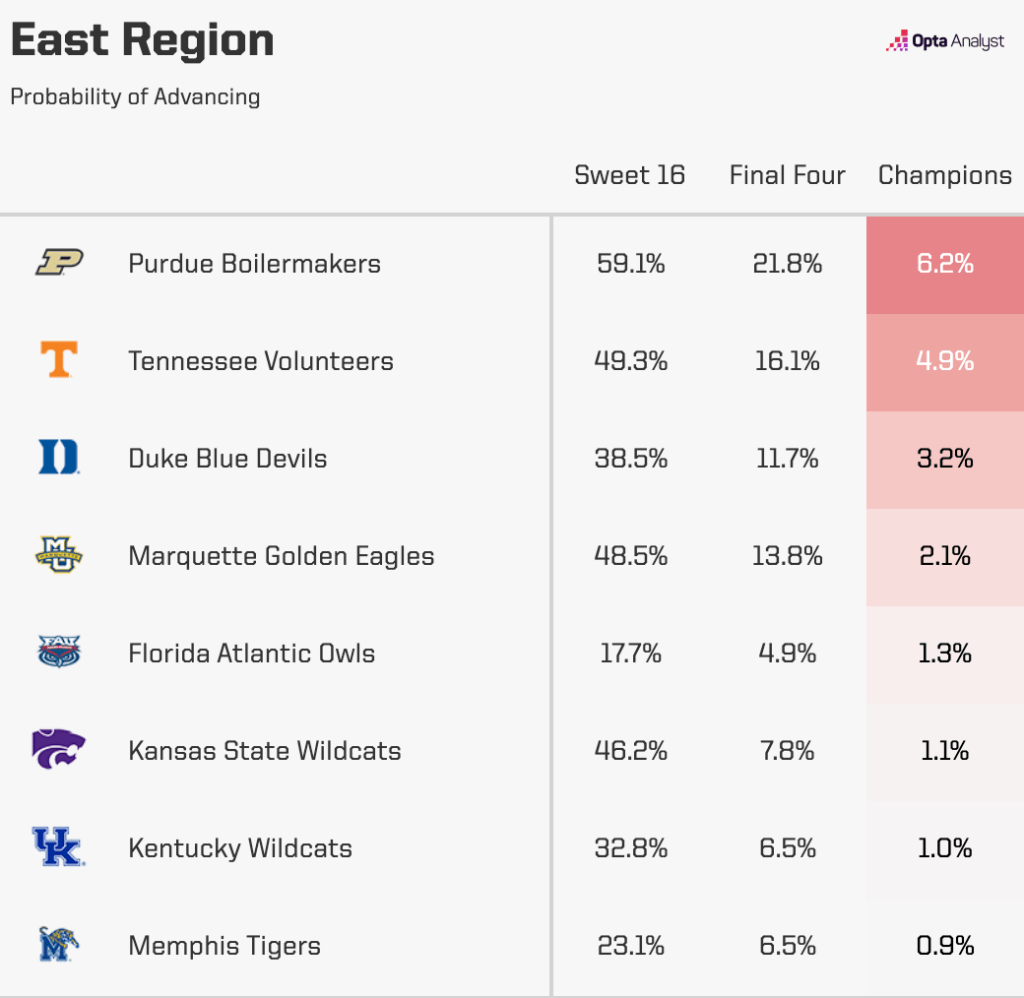
Here’s something to note: The four No. 8 seeds have an average TRACR of 23.4. That’s higher than the average TRACR for the fifth seeds, sixth seeds and seventh seeds.
The ninth seeds have an average TRACR of 23.1, which is much higher than the average for the seventh seeds (20.6).
Sixth-Seeded Cinderellas
Will the shoe fit for 11th seed once again? Or will a 15th seed make it to the Elite Eight like Saint Peter’s last year? My guess is that a sixth seed will make it far – at least the Elite Eight.
The sixth seeds in this tournament are Creighton (14th), Kentucky (24th), Iowa State (26th) and TCU (28th). The two teams out of the Big 12 will have to play the winner of the First Four games, which can throw either team off in terms of preparation. We have seen teams make runs out of the early Dayton games, like UCLA going from the First Four to the Final Four in 2021.
Of the four teams, three have at least a 65% chance of making it to the second round. The one exception is Kentucky (59.1), which does have a chance to knock off a third seed if it can survive its opener against Providence.
Creighton has a better TRACR than third-seeded Baylor (29th), which has struggled as of late. The Bluejays have a 40.6% chance of reaching the Sweet 16, slightly higher than the Bears’ 38.6% chance.
Could Creighton, which has a first-round matchup with NC State, earn a rematch with Arizona (12th) in the Sweet 16? The first matchup ended in a two-point win for the Wildcats on Nov. 23.
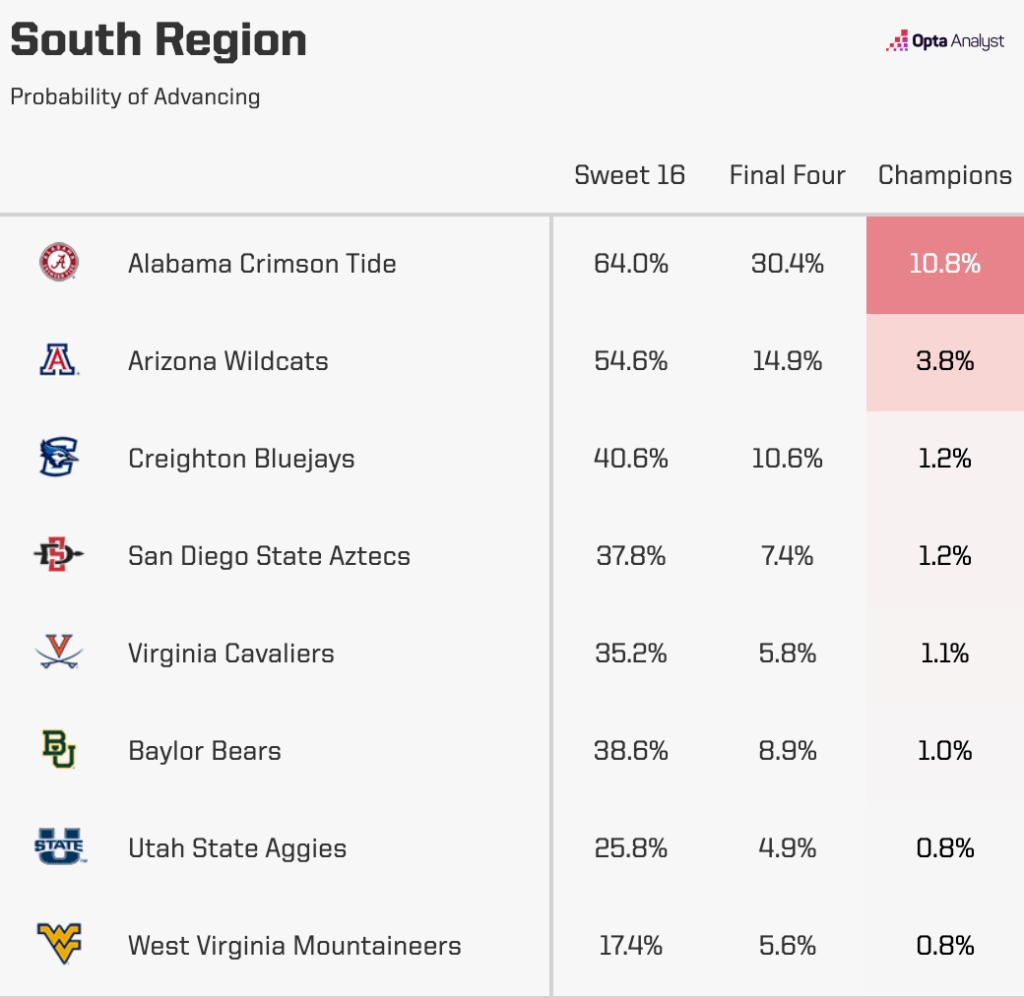
One team that might struggle to reach the second weekend, however, is TCU. If they get past either Arizona State or Nevada, the Horned Frogs would likely have to face a tough Gonzaga team in Denver. The Bulldogs have a tourney-best 66.4% chance of reaching the Sweet 16.
Perhaps one of the biggest enigmas of the season has been Kentucky, which was ranked fourth in the preseason AP Poll. The Wildcats looked terrible in January, losing to South Carolina (193rd) immediately after getting blown out by Alabama. The Wildcats have played better over the last 30 days, beating Tennessee at home and Arkansas on the road. Can John Calipari bring this team back and make a run? He did it in 2014 when he took Kentucky to the national championship game as an eighth seed.
Michigan State (5.6%) and Texas A&M (5.6%), who take on USC and Penn State, respectively, in the first round, have the best chance to reach the Final Four of the four seventh seeds, ahead of Missouri (2.7%) and Northwestern (2.5%).
Storylines Abound
What will break the brackets? What are the best storylines?
Here are a few potential scenarios that will be worth watching.
UCLA-Gonzaga Rematch
There has been no better game over the last five seasons than the UCLA-Gonzaga Final Four game in 2021.
It had everything – big plays, big names, a team going for a perfect season versus an 11th seed from the First Four. It was an overtime thriller that was capped off by one of the most unbelievable endings we’ve ever seen. It was watched by millions but took place with no one in the stands.
We had a rematch between the teams the following season when Gonzaga took down UCLA 83-63. Neither team made it past the Sweet 16, however. This season, only one will be able to advance. Both of these teams rank in the top 10 in TRACR and are talented enough to be crowned national champions. This would be the third time the teams have met in the regional semifinals – UCLA won in 2006, while Gonzaga won in 2015.
And, boy, we cannot forget about that game in 2006.
Kelvin Sampson vs. Indiana
Let’s wind the clock back 15 years. Indiana is one of the best teams in the country. Eric Gordon, the top recruit in the country, decommits from Illinois to come to the Hoosiers. The Hoosiers also bring in Jordan Crawford and Jamarcus Ellis. D.J. White is the Big Ten Player of the Year. The Hoosiers appear poised to make a deep run in the NCAA Tournament.
Kelvin Sampson, however, who arrived in 2006 after coaching Oklahoma for over a decade, was tagged with multiple recruiting violations in both October 2007 and February 2008 which led to his resignation. Meanwhile, Gordon raised issues about drug use on the team, which Sampson tried but failed to stop. Indiana lost in the first round of the tournament, Gordon went to the NBA, and the Hoosiers would go 28-66 over the next three seasons.
A possible rematch against Sampson would mean the world to Indiana fans who have not forgotten what that era did to the program. The Hoosiers (19th) have the talent to knock off TRACR’s No. 1 team, but they’ll have to go through a tough Kent State (76th) and either Miami (55th) or Drake (54th) to get there.
By the way, Kent State head coach Rob Senderoff was an assistant on Sampson’s staff at Indiana in 2008.
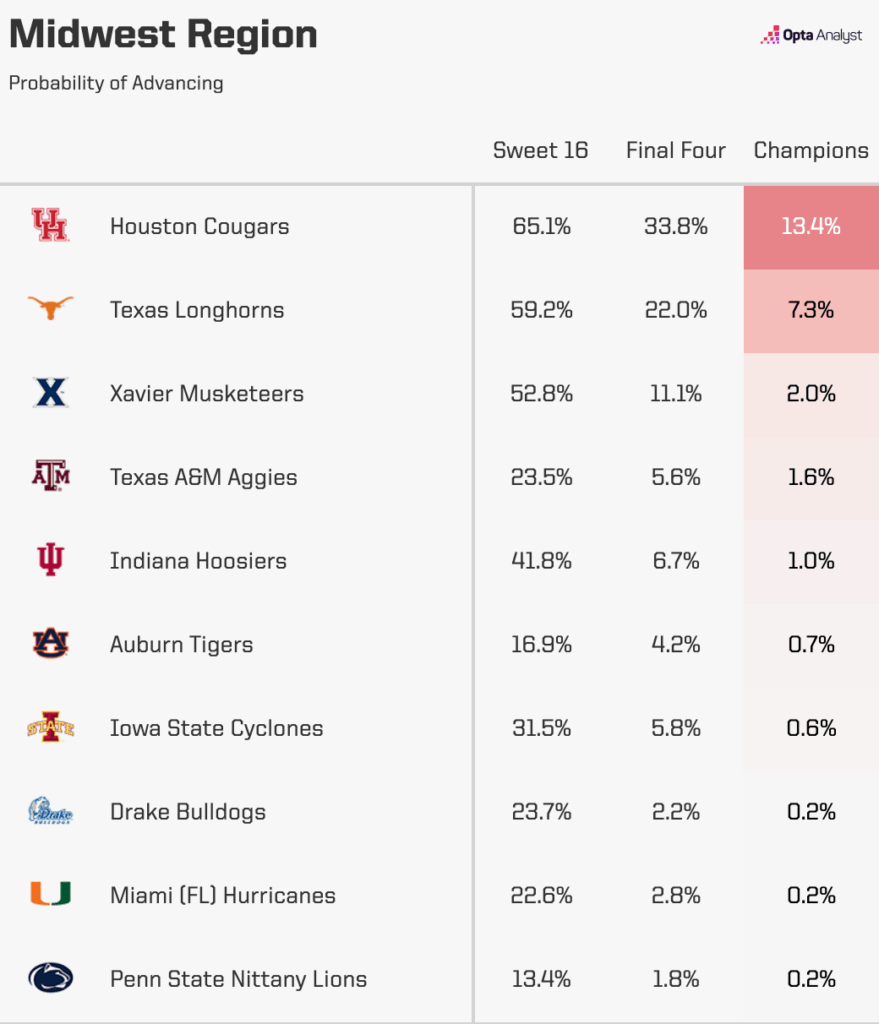
14th Seeds in the Sweet 16
The last two seasons have yielded a 15th seed not only winning a game but pulling off two upsets. Saint Peter’s reached the Elite Eight last season and Oral Roberts made it to the Sweet 16 in 2021. Could it happen again?
Well… hold on. Recall that both were milestones – only one 15th seed had made it to the Sweet 16 in the tournament’s history prior to 2021 – Florida Gulf Coast’s “Dunk City” team in 2013. There are some excellent No. 2 seeds this season, too.
What about the third seeds? Could they falter and lose to a 14th seed? Baylor (29th) has lost four of its last six games. Kansas State (23rd) enters the tournament having lost its last two. Xavier (16th) has run hot and cold, as shown by its 22-point blowout win over Creighton and a 14-point loss to Marquette in the Big East Tournament.
Gonzaga (No. 4) may be secure, but Bryce Drew’s Antelopes of Grand Canyon (124th) have been here before. And Bryce Drew knows a little thing or two about miracles.
Unlike the women’s NCAA Tournament, there may not be a clear favorite here and it’s possible that a fourth seed or higher wins the championship.
